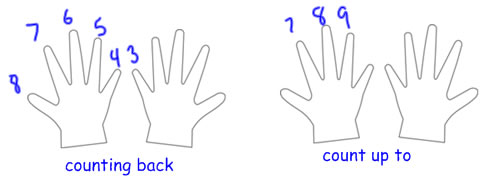
Counting up to is a useful counting strategy for subtraction, though it is not as natural an association as counting back.
Counting back is a natural strategy to use in solving JCU: Join Change Unknown problems. Counting up to is similar to counting on. The difference is that if you are counting on, you know how many more to count, and if you are counting up to, you know where to stop counting. Counting up to looks something like this:
Karen made 7 pictures. How many more does she need to make to have 9 pictures?
I start with 7 pictures. I make some more... 8 (put up 1 finger), 9 (put up another finger). She needs to make 2 more (the number of fingers held up--the number of counts).
This is a lot like the counting up to JCU strategy that children do with manipulatives, with the difference that the first number (7) is not represented, only the number counted on is represented.
Counting up to to subtract is significantly easier than counting back to subtract because we're all better at counting forwards than backwards, and we're all more likely to make mistakes when counting back than counting forward. Most of us, however, think of subtraction as taking away, so for counting up to to be associated with subtraction problem types other than JCU, children need to make the connections between addition and subtraction (addressed in an upcoming lesson!). In the example of Karen's pictures, you can think of the problem numerically in two ways:
7+?=9
or
9-7=?
The more natural representation is the missing number addition, so it's not automatic that children who know how to count up to to solve JCU problems will apply that same strategy to other problems where it would numerically make sense.
When introducing counting up to, you should ask questions for which counting up to is an efficient and a natural strategy. This means you want a JCU problem (to make the counting up to strategy more natural) and a problem where the minuend and the subtrahend are close (the difference should be 1 or 2). The problem about Karen's pictures is a good example.
Problems for which counting up to is an efficient strategy are ones where the minuend and the subtrahend are close together. That is the same as saying that the difference is small (the number of counts is small) but we usually talk about it as saying the minuend and the subtrahend are close because when you have a subtraction problem you know the minuend and subtrahend, but you don't know the difference until you solve the problem. Close in this case means 1 or 2 apart, maybe 3.
One thing to keep in mind about efficiency is that we want it to be easy enough that children, with a little practice, will be able to do the process without using their fingers--they will be able to keep track of the counts in their head without putting down their pencil.
When discussing efficiency of counting back and counting up to with children, it's nice to have a problem that's easy-ish to see in both ways: both as subtraction and as missing number addition. PPW-PU problems are good for this:
Sam had 9 notebooks. 6 were blue and the rest were red. How many red notebooks did he have?
It's pretty easy to think of having Sam's 9 notebooks, and taking away the 6 that are blue, and seeing how many are left. I'd do this by counting back from 9, holding up a finger with each count to keep track of taking away all 6 notebooks: 9....8 (1 finger), 7 (2 fingers), 6 (3 fingers), 5 (4 fingers), 4 (5 fingers), 3 (6 fingers). He has 3 red notebooks.
It's also pretty easy to think of this as a missing number addition: 6 blue notebooks + ? red notebooks = 9. Start with 6 and count up to 9 to find the number of red notebooks. 6... 7 (1 finger), 8 (2 fingers), 9 (3 fingers).
In this case, 6 and 9 are pretty close, and 6 is a pretty big number to be taking away, so here counting up to is a better strategy. The efficiency of the strategy is tied to the numbers you are computing with, not to the problem type.
Karen had 7 balloons. Two of her balloons popped. How many balloons does she have left?
If you ask a group of children to solve this problem, and ask how they solved it, it is very likely that some children will solve the problem by counting back. It's generally helpful to point out efficient strategies for solving problems, and counting back is one efficient strategy for solving this problem.
Some children will use a counting strategy where you count back to, so for 9-6, they might count back from 9 to 6. This would look like: 9... 8 ( finger), 7 (2 fingers), 6 (3 fingers). This strategy is about as efficient as counting up to for numbers where the minuend and subtrahend are close, and some children find it more natural to do. There are two reasons why we would like children to get used to counting up to for subtraction: the first is that counting forwards is easier and less prone to error than counting back. The other reason is that it both requires and reinforces an understanding of the relationship between addition and subtraction, which leads to other more efficient subtraction strategies.